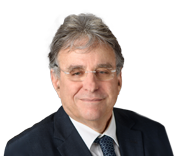Two of the biggest hurdles in bone marrow transplantation for treating blood cancers are preventing a patient’s immune system from rejecting the transplant, and graft-vs.-host disease, where the immune system of the donor attacks the patient’s organs. These factors usually require a close match between donor and patient.
But now an immunologist recruited to the University of Texas MD Anderson Cancer Center brings novel insights about finding ways to trick the immune system into accepting transplants it would otherwise reject, potentially widening the pool of donors. Yair Reisner was recruited in 2018 from the Weizmann Institute of Science in Israel, where he held an endowed chair in immunology, with the help of a Recruitment of Established Investigators Award from CPRIT. He serves as Director for Translational Research at MD Anderson. A clinical trial based on his research began in July 2019.
In the 1980s, Reisner performed the first successful mismatched bone marrow transplants in so-called “bubble babies,” children born without a functioning immune system, many of whom lived in isolation from birth for fear of infection. Reisner demonstrated that he could cure these children, using a mismatched donor, by cleansing donated marrow of hostile white blood cells through a process known as T-cell depletion — used now at hospitals around the world. The children developed normal immunity and did not suffer from graft-vs.-host complications.
In subsequent work, Reisner extended this T-cell depletion of mismatched donors to treating leukemia. Initially, he encountered problems with rejection, but eventually he found success in using very large doses — known as “mega-doses” — of blood-forming stem cells.
More recently, he focused on a type of immune cell called a “veto cell,” which helps the immune system distinguish cells that belong from cells that are foreign, and can help prevent rejection of T-cell depleted bone marrow.
The new clinical trial will use mega-dose transplants in combination with veto cells grown in a laboratory, to not only help the recipient’s remaining immune system accept the transplant but also prevent the transplanted immune system from attacking the host.
This combination — which doesn’t require as much chemotherapy and radiation — could also make older patients, who normally can’t survive the preparation, eligible for transplants. “We hope to open a new modality for safer haplo-identical transplants, which are very important for many diseases, not just blood cancers,” Reisner says.
He has also successfully used lung stem cell transplants to cure lung disease in mice. Reisner envisions that transplanted lung stem cells could permanently reestablish lung function in people suffering from diseases like chronic-obstructive pulmonary disease or cystic fibrosis. He is excited about the possibilities. “It will be a few more years before we can translate this to humans,” he says, “but it crosses genetic barriers and works beautifully in mice.”
At age 70 in Israel, Reisner would have been forced to retire, but he knew he had more to offer. Because MD Anderson has the world’s largest stem cell transplant and cellular therapy program, Reisner thought a move to Texas offered the best possibility of extending his basic research into clinical trials. “These two major projects are now occupying 12 people very intensely,” he says, “thanks to the fantastic grant from CPRIT.”
Reisner received his undergraduate degree in chemistry from Hebrew University in Israel, and a master’s degree in biochemistry from the University of California, Berkeley. He returned to Israel for his Ph.D. in biophysics, which he received from Weizmann. Following a research fellowship at Memorial Sloan-Kettering Cancer Center in New York, he began his career at Weizmann in 1981 as a senior scientist, becoming Henry Drake Professorial Chair of Immunology 1998. He was chair of immunology for nine years, and headed Weizmann’s Gabrielle Rich Center for Transplantation Biology Research for 11 years.
Read Less

